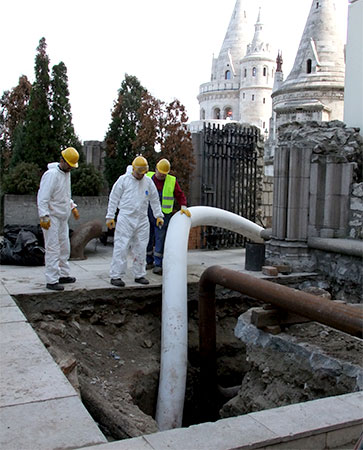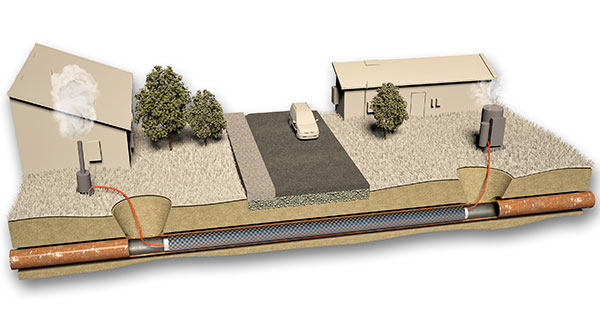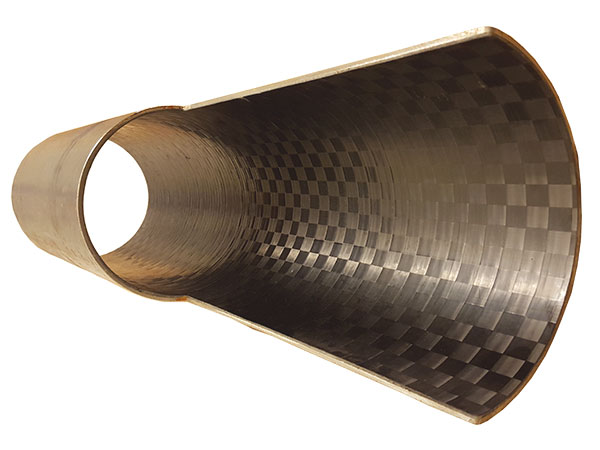Renovation of District Heating Pipelines by Trenchless Technology
Authors: Zoltán Varga and András Lőrincz
Innotéka Magazin - Vol. VI. - May, 2016.
Condition of public pipelines having been laid decades ago has significantly deteriorated by now. Their continuous and flawless operation provides the operator with a constantly growing duty. Unexpected failures may cause serious inconveniences in the environment. Rehabilitation as well as reconstruction of these public pipelines will be an important task in the future. Trenchless technologies, the so called No-Dig procedures have come to the fore instead of applying traditional open trench reconstructions. These technologies ensure quick, efficient and inexpensive rehabilitation of underground public pipelines while causing minimal environmental disturbances. There is no need for major excavations, during the application we are using the inner space of the pipeline where different linings, liners can be inserted without any disturbance to the environment.
Application of No-Dig procedures has more than a 40-year-old history in Hungary. In the beginning, refilling technologies such as: Supersilic, Superaqua, glykolizing, Buna Latex, Posatryn were used for the rehabilitation of the gasket sealing of sewage and gas pipelines. Further methods for on-the-spot repairs were Weco, Amex, Short Liner where a gasket mender was inserted in the inside of the pipe. Procedures using cured-in-place liners represented significant progress - Instituform, Process Phoenix. Here we build up a composite pipe inside the pipe to be rehabilitated consisting of a resin, a carrier and a sealing coating.

Fig. 1. Trenchless rehabilitation of a public pipeline in Budapest
Time has also left its trace on public heating pipelines. Deterioration of their condition may result in leakage. Inner corrosion due to the ageing of public heating pipelines may cause a serious problem: heat loss would increase because of leakages and this might as well endanger the operation of the network. Rehabilitation of the pipelines therefore may become necessary and many times these pipelines are hard-to-access as they are lying under highways, railroads. Furthermore, other underground public pipelines may also make difficult the replacement or the rehabilitation of old pipelines. In these cases trenchless pipe rehabilitation methods can provide a solution.
As a result of recent developments, from this year the rehabilitation of public heating pipelines has also become possible by using a trenchless cured-in-place (CIPP) pipeline rehabilitation procedure. The main point of this method is that after proper preparation (cleaning, CCTV inspection etc.) a liner is impregnated by a two-component resin being in the liquid phase and then pulled into the pipe. The liner is put under pressure and polímerization is set off by using steam. The liner then hardens, sticks to the existing pipe and a new (liner)pipe is formed within the pipe to be rehabilitated. The liner will also solve further corrosion problems and will make the pipe fully dense and pressure resistant. This concept is certainly widely known and used in the territory of public pipeline rehabilitation but we have had to wait right until now for the development of special lining materials suitable to be built into public heating pipelines. Resin types formerly used in other public pipelines proved to be unsuitable to resist the complex effect of humid environment, elevated temperature and high pressure which was a major problem in the course of development. Fibres get to be demineralized by the hydrolysis of the resin, strength properties of the composite material would change significantly so the liner cannot meet the requirements expected.

Fig 2. Lining of public heating pipelines
The solution here is a special composite liner which consists of one specific carbon fibre liner and an epoxy resin applicable in humid environment at a high temperature. Available technology can be applied up to DN 800 mm diameter for the rehabilitation of public heating pipelines. The medium delivered can even be of 140 °C.

Fig 3. Relined public heating pipe
Agriapipe Kft. is just planning the completion of a pilot project in the middle of this year in order to present this revolutionary new technology on site. We do hope that the introduction of this procedure in Hungary being very new to the market will make a good quality alternative available for the operators in the territory of public heating pipeline rehabilitation.
See original article here: innoteka.hu/online/agriapipe-article
